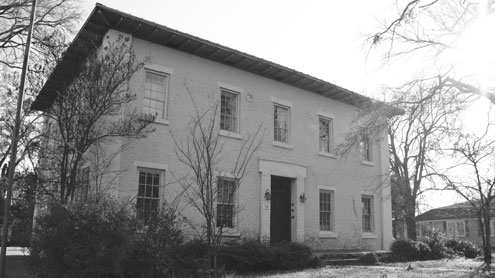 Prisoners are no longer trapped within its confines, but after more than 150 years of service, the old Tuscaloosa County Jail still manages to capture the attention of many 6th Street passersby.
Prisoners are no longer trapped within its confines, but after more than 150 years of service, the old Tuscaloosa County Jail still manages to capture the attention of many 6th Street passersby.
Tuscaloosa served as Alabama’s capital city from 1826 to 1846. Across the street from the jail, the rubble in Capitol Park is the ruin of the old capitol building.
According to a Tuscaloosa News article from July 1979, the jail was originally the site of a hotel in which state legislators would stay during visits to the capitol building. When the state capital was relocated to Montgomery in 1846, the hotel was converted to a prison.
The reconstruction process was completed in 1856 by William B. Robertson, who was paid $8,028 for his work, according to Sandra S. Townsend in “The Old Jail Remembers Tuscaloosa.” The builder installed a living area downstairs for the sheriff and his family, and individual cells were placed on the second floor for inmates.
As Townsend wrote, the building quickly developed a reputation as “the strongest jail in the Southeast.” With its 28-inch thick “brick walls, solid log decking between floors and other security features,” the prison outpaced many of its contemporaries, most of which were outfitted solely with “simply masonry or log cube,” according to a January 1980 Tuscaloosa News article.
Despite its reputation, however, the jail was not completely inescapable – one man managed to bust loose. Stephen S. Renfroe, the “Outlaw Sheriff of Sumter County,” staged his famous getaway in July of 1884.
“That’s the most interesting story you’ll be able to find about the Old Jail,” said Sarah Wiggins, UA professor emerita of history. “He burned a hole right through the floor.”
According to William Warren Rogers in “Alabama’s Outlaw Sheriff, Stephen S. Renfroe,” Renfroe was elected sheriff of Sumter County in 1877 before being arrested in 1880 on a multitude of charges, including breaking into his own office twice. After an escape attempt from the Sumter County Jail, he was transferred to Tuscaloosa because “the sturdy Tuscaloosa jail was considered safe, even from the assaults of such a man as Renfroe.”
Renfroe wasted no time in disproving that assertion. Each day for several months, he saved half of the match a guard gave him to light his cigarette. On the night of July 7, 1884, after he had saved 34 matches, the Outlaw Sheriff moved the bathtub he had cut away from the wall earlier, burned a hole through the second story floor, climbed through the opening and escaped through a first floor window.
According to Townsend, the county built a new jail in 1880, and the building was converted to a home for delinquent girls. John J. Nielson bought the property in 1912 and operated a boarding house until he sold the building to the Veterans of Foreign Wars Club in 1940. The VFW used the structure as their clubhouse until 1980, when they had to sell it to cover an unpaid mortgage balance.
Tuscaloosa City Schools purchased the Old Jail in 1980 as the home for its American Studies program, in which high school juniors would meet in the prison every morning of a semester for “hands-on, alternative education,” which included “work at preserving and restoring the valuable historical structure,” according to an American Studies program pamphlet.
Since the program’s 2003 move to individual area high schools, the Old Tuscaloosa County Jail has stood empty, kept company by a few trees and neighboring homes. It was added to the National Register of Historic Places in 1979.
“It’s not really used for anything now,” said Katherine Mauter, executive director of the Tuscaloosa County Preservation Society. “I wish it was. I remember going there back when I was a Girl Scout.”







